|
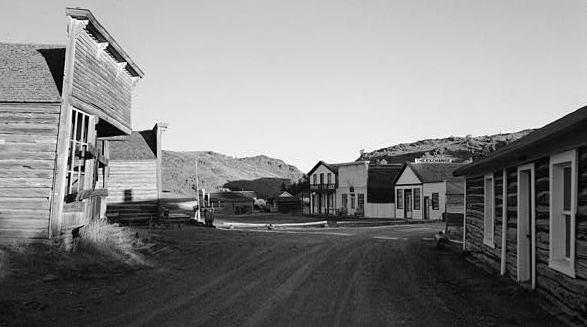
Modern view of South Pass City.
Ghost towns are frequently associated with played out mines. such is South Pass City,
perhaps, the most famous of Wyoming's ghost towns. Gold
was discovered in the area in 1842 by a trapper working for the American
Fur Company, but a "gold rush" did not occur until the opening of the Carissa Mine in
the 1867. The town was platted the same year and incorporated shortly thereafter.
It was designated as the county seat of Carter County, named after Judge Wm.
Carter of Fort Bridger, later renamed Sweetwater County. By 1868, the town had
stage service south to Bryan on the Union Pacific. By 1869, Iliff & Co. had opened the Exchange Bank, the
town had a newspaper and the town had a toll road to Atlantic City 2 1/2 miles away, tolls:
fifty cents for a wagon and two horses, twenty-five cents for two horses, and stray
stock five cents each. For discussion of the discovery of South Pass see Lander.
Bryan, now accessible by four-wheel drive, consists only of a few foundations. In
1868, Bryan was expected to become an important center of communication.
It had a railroad roundhouse. In addition, Bryan was served by the Williamson & Co.
Bank and by Martin's Hotel, an imposing
50 ft. by 125 ft. two story structure. The stage service advertised roundtrip fares in covered "spring carrages,"
leaving from Martin's Hotel to Jenk's Restaurant in Green River City, for only $5.00. "Spring carriages" were not
necessarily comfortable. Elmer Carlson, of Cody, writing of stage service in
Meeteetse, described the reactions of several passengers after their experience in stages
using covered "spring" wagons as coaches: "One young eastern fellow rode
the stage from Cody to Meeteetse and when asked if he would ride it back
replied it would be a whole lot more comfortable to walk back. Andy Wilson
said he wouldn’t pay a dollar to ride from Meeteetse to Thermopolis,
couldn’t earn a dollar easier than to just light out and walk it."
The Union Pacific was concerned about lack of water in Bryan, not only for the locomotives, but also for
the roundhouse. The railroad moved the roundhouse to Green River City. Bryan faded away.
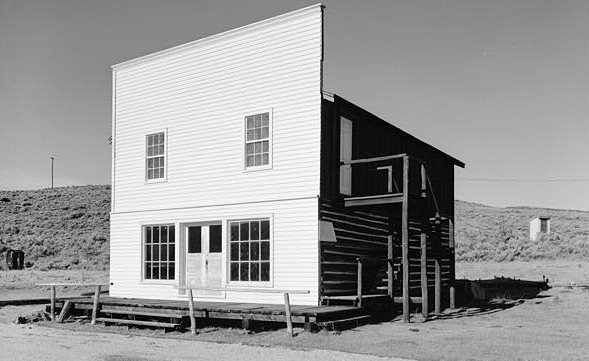
Masonic Lodge, South Pass City
For discussion on history of
the Masonic Order see discussion on Cheyenne III. In the early 1870's disputes
arose with Green River City as to the location of the seat with, pending an
election, the Board of County Commissioners meeting first in South Pass City, then
in Green River City, back to South Pass City. When the election was held Green
River City won, but it still required a law suit against the Board to get
the move made. Meanwhile, in the various moves back and forth, some of the County's
financial records were stolen. In 1871, a fire destroyed several buildings including
the newspaper. The result of the fire, loss of the county seat and the coming of
the railroad to Green River, bypassing the town was its failure. In 1884,
county lines were changed and the town became part of Fremont County.
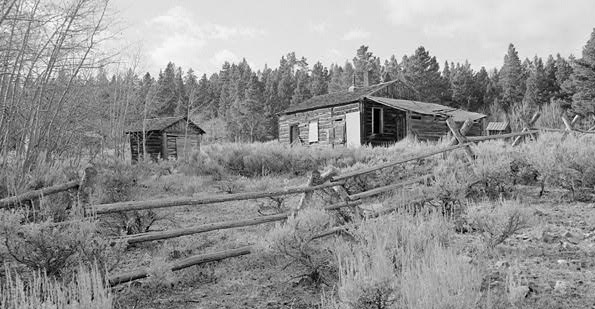 Cabin, Miners Delight
The privy to the right and behind the cabin is a "two-holer." See photo below right.
Miners Delight, originally Hamilton City, located about 2 1/2 miles from
Cabin, Miners Delight
The privy to the right and behind the cabin is a "two-holer." See photo below right.
Miners Delight, originally Hamilton City, located about 2 1/2 miles from
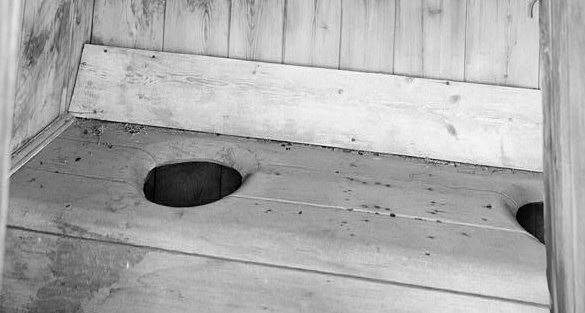 Atlantic City, received its start with the discovery of the Miners Delight
Mine in September 1867. By 1869 some $60,000-$70,000 in gold had been recovered
from the mine resulting in the change of name from Hamilton City to Miners Delight.
by 1870 the town had attained a population of 70 including 40 miners, 1 farmer, and 1
liquor dealer. Mining declined and between 1882 and 1907 the town was completely
abandoned. In 1907 the Miners Delight Mining Company attempted to resume
mining. During the depression many of the otherwise abandoned cabins were
occupied by the jobless. Most of the sructures in the town date to the 1907
period, it being doubtful than any structures date back to the original town.
Atlantic City, received its start with the discovery of the Miners Delight
Mine in September 1867. By 1869 some $60,000-$70,000 in gold had been recovered
from the mine resulting in the change of name from Hamilton City to Miners Delight.
by 1870 the town had attained a population of 70 including 40 miners, 1 farmer, and 1
liquor dealer. Mining declined and between 1882 and 1907 the town was completely
abandoned. In 1907 the Miners Delight Mining Company attempted to resume
mining. During the depression many of the otherwise abandoned cabins were
occupied by the jobless. Most of the sructures in the town date to the 1907
period, it being doubtful than any structures date back to the original town.
Atlantic City was founded in 1868, by Tozier, Collins & Thompson. At one
time the town supposedly attained a population of 2,000, although the 1870 census only reflected
a population of 321 whites and 4 blacks. The town claimed the honor of
having the first brewery in the Territory. Atlantic City was noted for its "French"
section which appealed to lonely miners. After the intial gold rush the town
began to fade until the arrival of Emil Granier who attempted to revive mining.
Unfortunately, several mine explosions killed his hopes and he returned to
his native France destitute and spent his last years in debtors' prison.
Hopes for the town's revival again arose in the 1962 with the coming of surface
iron ore mining, but were dashed with cessation of operations in 1983.
As noted with regard to the discussion of Sherman on the
next page, as the Union Pacific moved west there were created instant boom towns at the
end of the line serving the grading crews and providing a "jumping off" spot for
those heading further west. A few of these instant towns, typically division points such as Cheyenne and Laramie, became
permanent cities. Others such as Sherman lasted a little longer. Others which
consisted little more than tents and a few shanties in which saloon keepers,
gamblers, and soiled doves plied their respective trades, may have lasted only a matter of
months. As the tracks were
extended the inhabitants of the towns would pack up, load up on wagons and move to
the next town, giving rise to the expression, "Hell on wheels."
In 1868, at the peak of railroad construction, the Territory had a population of about 16,000, but by
mid-1869 the population was only a little over 8,000. 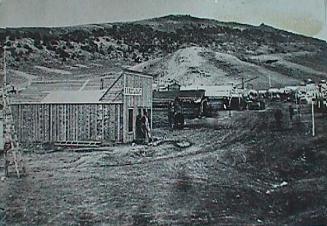
Bear River City, Wyoming Territory
Of such a nature was Bear River City about 10 miles south of Evanston. Bear River City, 1867, pictured below right,
is not to be confused with the city of the same name in
Utah, Bear River City, at its peak had a newspaper, The
Frontier Index, published by Legh Freeman. Freeman, utilizing a box car as a printing office,
followed the tracks starting his newspaper in Fort Kearney, and
moving westward to Julesburg, Cheyenne, Fort Sanders, Green River City and Ogden. Freeman was not,
however, a milquetoast in expressing his opinions as to fraud by the Railroad or his opinions as to others.
In the November 15, 1868 edition of The Index he expressed his opinions as to Blacks, Indians and Chinese.
If his opinions didn't get the attention of the gentle reader,
he persisted several days later with a vitriolic
attack on the L.D.S. and a call for the lynching of three accused murderers.
Following the necktie party, a group of vigilantes turned on him. Nineteen years later in the June 19, 1877 edition of the Ogden [Utah]
Freeman he described, with perhaps some exaggeration, the reason for his departure from Wyoming:
"The next morning at the break of day, when several thousand graders headed by the most villainous
desperadoes, beseiged the office, gutted and sacked it, and threatened to burn us in it, and would undoubtedly
have left nothing but a grease spot of our mortal remains had not a milk
white steed conveyed us to Fort Bridger, where we obtained troops, who arrested
the leaders and held the town under martial law until the large gangs of men
passed westward to the grading camps of Echo and Weber Canyon. Forty-odd
rioters are buried around the office. the only citizen killed in the melee
was Steve Stokes. The last of the cutthroats has died with his boots on and the ringleader had
his head chopped off with an ax."
The graders from Echo Canyon were, however, a bit rough. When the Echo Canyon saloon was
torn down years later, seven human skeletons were found under the floor boards. A more
accurate version of the November 19, 1868, Bear River City Riot was described by George Crofutt in his
1872 edition of Crofutt's Trans-Continental Tourist's Guide:
The Bear River City Riot cost sixteen lives, including that of one citizen.
The mob first attacked and burned the jail, taking thence one of their kind who was
confined there. They next sacked the office and destroyed the material of the
Frontier Index. Elated with their success, the mob, numbering about 300 well-armed
desperados, marched up the main street and made an attack on a store, belonging to
one of the leading merchants. Here they were met with a volley from Henry rifles, in
the hands of brave and determined citizens, who had collected in the store. The
mob was thrown into confusion and fled down the street, pursued by the citizens, about
thirty in number. The first volley and the running fight left fifteen of the
desperados dead on the street. the number of wounded was never ascertained, but
several bodies were afterwards found in the gulches and among the rocks, where they had
crawled away and died. One citizen was slain in the attack on the jail.
By 1872, Crofutt reported that nothing of Bear River City was left except some chimneys and rusted oyster tins.
Among those who assisted in putting down the riot was a former New York City
police officer, Thomas James Smith. Smith, as a result of his actions, earned the
appellation "Bear River Tom." Smith subsequently became the first town marshal of
Abilene, Kansas. There he, among other things, closed down the "Red Light District" after
a murder in one of the "dens of iniquity." Smith was killed on November 2, 1870,
while attempting to arrest Andrew McConnell. Smith was buried in a $2.00 grave. In 1904 the
City removed his remains to a more prestigious part of the cemetary and provided a grave marker. Smith's
year of birth is given by various sources as 1830, 1835, and 1840.
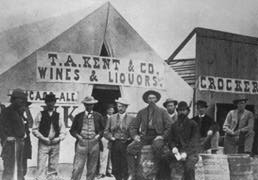 Benton, Wyoming
Benton was Wyoming
Territory's first ghost town. Benton, 11 miles east of present day Rawlins at UP milepost
672.1, lasted only three months from July to September 1868, and attained a population of 3,000.
During that period, however, it provided an interesting contrast. On one hand, it had
twenty-five saloons and five dance halls. During its brief existence, reputedly over 100
souls met their Maker in gunfights. One visitor referred to Benton as
"nearer a repetition of Sodom and Gomorrah than any other place in America."
On the other hand, General Grant during his 1868 visit to Wyoming visited the town. Additionally,
the town in August and September 1868, provided the jumping off location for
2,000 Saints in 5 companies heading to Utah.
The election of Grant brought out the voice of moderation, Legh Freeman, who
again excited the attention of his readers, many of whom were Union veterans. Freeman,
a former Confederate sympathizer, referred to Grant as
"the whiskey bloated, squaw ravishing adulterer, nigger worshipping mogul
rejoicing over his election to the presidency."
More ghost towns on next page.
|